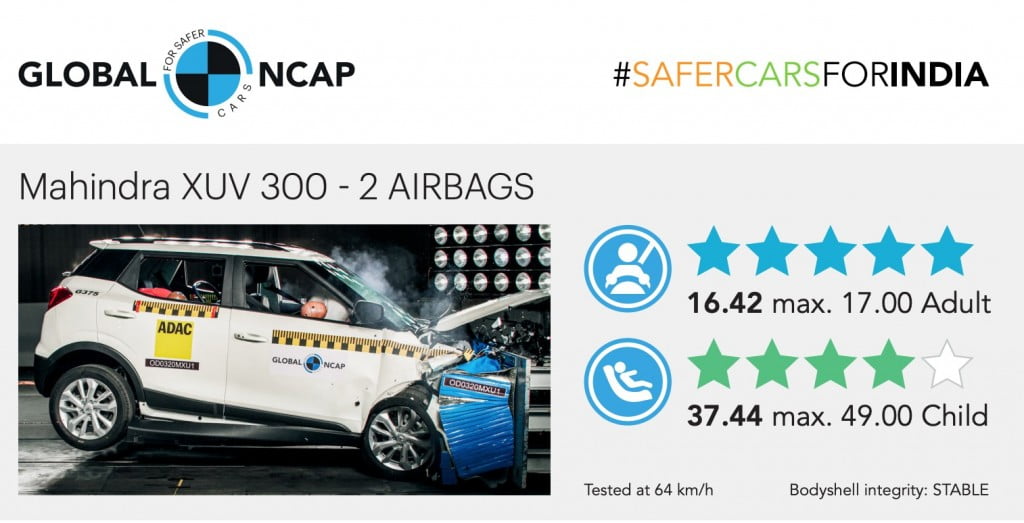Indians were made aware of the Global NCAP safety rating system after Tata Nexon got its 5-star rating back in 2014. This was something new for the customers because until then, the only factors worth considering before buying a car were mileage and maintenance costs. Thereafter, a sort of streak started wherein, people would at least start glancing through the safety rating of the car. This trend is in full effect now, as more and more indigenous cars started getting 5-star safety rating.
Also read: Mahindra Thar secures a 4-star Safety Rating in Global NCAP!
For example, the Tata Altroz is the only 5-star hatchback in the country at the moment. Apart from that, Mahindra XUV300 impressed everyone with a 5-star rating. What is particularly interesting is that XUV300 secured 16.42 points out of 17 in adult occupancy. This has ensured that the company makes safety a priority and the consumers can choose their peace of mind.
Tests in Global NCAP Testing
Global NCAP (New Car Assessment Program) was established in 2011 in the UK to ensure cooperation between various NCAPs around the world. The others include Australasian NCAP, Korean NCAP, Latin NCAP, Japan NCAP, Euro NCAP and ASEAN NCAP. These are independent organizations for the respective regions/countries. Essentially, the aim of Global NCAP is to make the buyers aware of the safety aspects of the vehicle, so that they demand safety equipment from the car manufacturers. This forces carmakers to equip their models with the best safety kit. The testing procedure to secure the safety ratings include:

Full frontal, front offset, side impact and side pole tests
These tests are conducted at a speed of 64 kmph. Although each NCAP has different tests, the Global NCAP conducts on front offset crash test. In this test, a car at a speed of 64 kmph crashes into a deformable barrier with 40 percent overlap. This produces the same impact as a crash between two cars, each at a speed of 50 kmph. Various aspects of vehicle safety are assessed and the points are awarded accordingly. Euro NCAP being the toughest rating system takes into consideration all the above-mentioned testing procedures.
Also read: Check out how the Kia Seltos performed at the Global NCAP!
Occupancy Test
This test involves adult, as well as child occupancy protection. The number of airbags or the body structure of a car during a crash is the factor that influences the points in this system. The front passenger is treated as the adult in this case and damage to various parts of his/her body will define what security rating it will receive.
At the rear, the ISOFIX child seat mounts are used to hook on the seating of a baby. Depending upon the damages to the dummy (baby), the risk is assessed and points are awarded. Adult and child safety in their own respective safety ratings.
Also read: Look at the score of Hyundai Grand i10 Nios at Global NCAP!
Bodyshell Integrity
As the name suggests, it denotes whether the bodyshell or the structure of the body of the vehicle is stable or unstable. It undergoes a few crash tests and in the end, if the body of the vehicle is able to take even more load on the body, it is termed as stable. However, if the vehicle is deformed under this load, it is declared unstable.
Active and Passive Safety Features
Passive safety features include the equipment which is deployed after the accident has taken place, for example, the airbags. This will try to make sure that the injuries and damage can be contained. In contrast to this, active safety features include Vehicle Stability Program, Roll-over Mitigation and Emergency Braking System, which can avoid the collision in the first place. Depending upon the number of features in a particular car, along with their effectiveness, determines the score of this segment of tests.
Taking all these factors into consideration, a final score sheet is generated and the car is deemed safe or unsafe accordingly. Depending on the overall points scored, a final 0-5 star rating is rewarded to a particular vehicle.
Also read: Watch how Maruti Suzuki S-Presso performed at the Global NCAP!
India is the 5th largest automobile manufacturer in the world at the moment. However, it is the only one in the top 5, that does not have an NCAP testing system. But the government is pushing for this since 2014. The Automotive Industry Standard will surely take this forward and we will definitely have a Car Safety Assessment Program of our own sooner rather than later.
The post How Do Cars Get NCAP Safety Ratings? appeared first on Car Blog India.
from Car Blog India https://bit.ly/2KNaPH2
Comments
Post a Comment